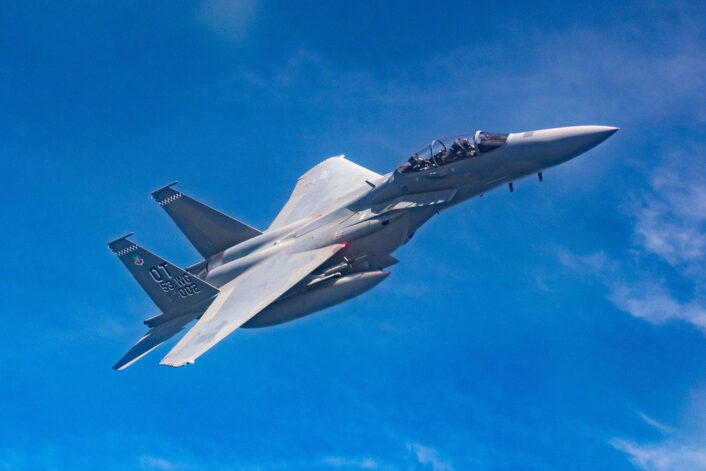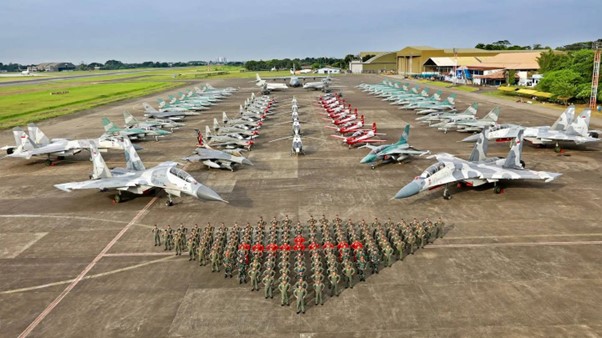The country is set to become the first export operator of the F-15EX, which will be known as F-15IND once in service.
Indonesia and Boeing signed a Memorandum of Understanding to finalize the sale of 24 F-15EX Eagle II aircraft during a visit of Indonesia’s Minister of Defense Prabowo Subianto to the United States on August 21, 2023. Although the sale is subject to the U.S. government approval, this should just be a formality, as last year the U.S. Defense Security Cooperation Agency already approved a possible Foreign Military Sale to Indonesia for up to 36 F-15EXs.
“We are pleased to announce our commitment to procure the critical F-15EX fighter capability for Indonesia,” said Minister Subianto who witnessed the MoU signing. “This state-of-the-art fighter will protect and secure our nation with its advanced capabilities.” With Rafales and possibly KF-21s also on the way, Indonesia is sure building a state-of-the-art fleet to replace its legacy aircraft types.
We’re honored to host Indonesian Minister of Defense Prabowo Subianto on a tour of our F-15 production line in St. Louis.
Indonesia is an important partner and we are humbled that they have chosen F-15 to advance their capabilities for the future.
More: https://t.co/DEegc15qkw pic.twitter.com/Hnz28Eoq0J
— Boeing Defense (@BoeingDefense) August 22, 2023
The F-15EX
The F-15EX is the most advanced version of the F-15 ever built, with digital fly-by-wire flight controls, a new electronic warfare system, an all-glass digital cockpit, and the latest mission systems and software capabilities, which will all be leveraged in delivering the new F-15IDN, says Boeing. No details have been provided about the configuration of the aircraft, even if some US-only systems are expected to be removed.
“We have invested years of expertise into developing the F-15EX capabilities. There is no other fighter like the F-15 in the world, and this platform will put Indonesia at the top of air dominance capabilities,” said Mark Sears, Boeing Fighters vice president and program manager. “Boeing is ready to support this effort and remains a committed partner to the U.S. government in advancing international security objectives with allies and partners around the world.”
According to last year’s DSCA announcement, the proposed F-15IND will come with the AN/APG-82(v)1 Advanced Electronically Scanned Array (AESA) radars, AN/ALQ-250 Eagle Passive Active Warning Survivability Systems (EPAWSS), Advanced Display Core Processor (ADCP) II digital computers, Joint Helmet Mounted Cueing Systems (JHMCS) for both pilots and Weapon Systems Officers (WSO), AN/AAQ-13 LANTIRN navigation pods, AN/AAQ-33 Sniper Advanced Targeting Pods (ATP), MS-110 Recce Pods, AN/ASG-34 Infrared Search and Track International (possibly integrated in the Sniper’s pylon).

It is interesting to note the presence of the EPAWSS in the equipment list, as it was previously considered a US-only system. The ALQ-250 is an advanced electronic warfare and electronic surveillance system, which is fully integrated with radar warning, geo-location and increased chaff and flare capability to detects and defeat surface and airborne threats in signal-dense and highly contested environments, according to BAE Systems.
Indonesia’s future plans and wide variety of aircraft
Last year, Indonesia and France signed a deal for 42 latest-generation Rafale fighter aircraft, with a comprehensive package that covers aircrew training, logistical support for several Indonesian air bases, and a training center with two full-mission simulators. Earlier this year, Indonesia also signed a contract to acquire the Qatar Emiri Air Force’s (QEAF’s) total fleet of 12 Dassault Mirage 2000-5 fighter aircraft prevent a decline in the combat effectiveness of the Indonesian Air Force while waiting for deliveries of the new aircraft.
Apart from the F-15EX, Rafale, and Mirage 2000 the country also has commitment to the KF-21. With Indonesia being South Korea’s main partner in the KF-X program, it is set to burden roughly 20% of the development program. Whilst the country is not in charge of R&D, it is planning on manufacturing 50 airframes after the prototype phase. Indonesia is set to receive the fifth KF-21 prototype once its backlog of payments to the program is resolved.
The country currently operates a combination of Western and Eastern aircraft. The Indonesian Air Force (Tentara Nasional Indonesia-Angkatan Udara TNI-AU) has a total of 33 F-16 (23 F-16C/D, 7 F-16AM/BM, 3 F-16A) and a mix of 11 Su-30MK2 and 5 Su-27SKM that serve as the backbone of the fighter force. The last set of Su-30MK2s were delivered in 2013. The F-16A/B were the first variants to enter service in the TNI-AU in 1989. Later ex-USAF F-16C/D Block 25s were bought and the airframes upgraded to Block 32 specs. With the force facing operation of two different variants, the decision was made to upgrade the existing fleet of A/B models into F-16AM/BM in line with the more modern C/D fleet.

Apart from the mainline fighters, TNI-AU also operates BAE Systems Hawk 200, EMB-314 Super Tucanos, and T-50i as light attack aircraft. With the South Korean T-50i being used as both Lead In Fighter Training (LIFT) and an attack platform, Indonesia decided to buy 6 additional airframes in 2021.
With previous ties with the former Soviet country dissolving, the Indonesian Air Force seems to be transitioning closer to Western air platforms. Indonesia is in a strategic position in the light of the great power competition with China, and it should be no wonder that the United States and France are willing to equip the TNI AU with their newest fighter jets. This was also mentioned in the DSCA notice last year: “This proposed sale will support the foreign policy goals and national security objectives of the United States by improving the security of an important regional partner that is a force for political stability, and economic progress in the Asia-Pacific region. It is vital to U.S. national interest to assist Indonesia in developing and maintaining a strong and effective self-defense capability. The proposed sale will improve Indonesia’s capability to meet current and future threats by enabling it to provide increased deterrence and air defense coverage across a very complex air and maritime domain. Indonesia will have no difficulty absorbing these aircraft and equipment into its armed forces.”
Yet Indonesia is an interesting example of a single force operating both US and Russian aircraft. Now with F-15EX and Rafales in the horizon, the combination of many different platforms raises the obvious question of logistic strain. This remains a question to be solved in the coming years for the personnel of the TNI-AU. This is expected to become an interesting test case and a test to the logistics chain involved in supporting a non-homogeneous force.
Meanwhile, just few days before the signing of the MoU for the Indonesian F-15INDs, Boeing finally rolled out the third F-15EX for the U.S. Air Force, which was built in the final operational configuration and likely incorporates all the possible modifications required after the test campaign at Eglin Air Force Base.
Eagle on the move! 🦅 #F15EX EX3 is moving from the factory to the ramp for flight testing before delivery to the @USAirForce later this year. F-15EX Eagle II is the newest tactical fighter for the U.S. Air Force. pic.twitter.com/Dy1gPiLdDj
— Boeing Defense (@BoeingDefense) August 16, 2023









